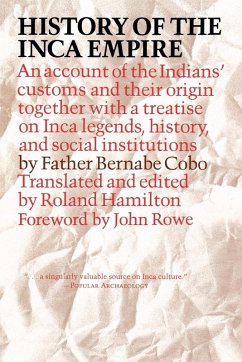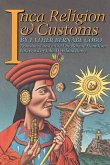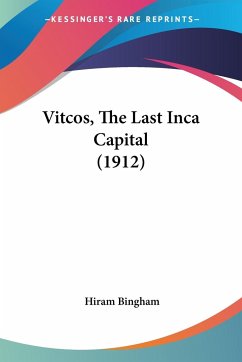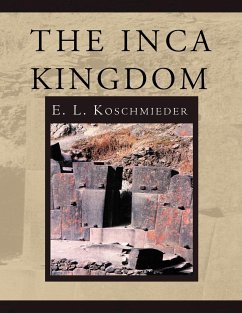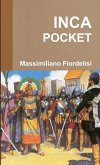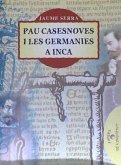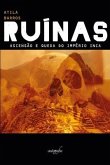Father Bernabe Cobo
History of the Inca Empire
An Account of the Indians' Customs and Their Origin, Together with a Treatise on Inca Legends, History, and Social Institutions
Father Bernabe Cobo
History of the Inca Empire
An Account of the Indians' Customs and Their Origin, Together with a Treatise on Inca Legends, History, and Social Institutions
- Broschiertes Buch
- Merkliste
- Auf die Merkliste
- Bewerten Bewerten
- Teilen
- Produkt teilen
- Produkterinnerung
- Produkterinnerung
The Historia del Nuevo Mundo, set down by Father Bernabe Cobo during the first half of the seventeenth century, represents a singulary valuable source on Inca culture. Working directly frorn the original document, Roland Hamilton has translated that part of Cobo's massive manuscripts that focuses on the history of the kingdom of Peru. The volume includes a general account of the aspect, character, and dress of the Indians as well as a superb treatise on the Incas-their legends, history, and social institutions.
Andere Kunden interessierten sich auch für
![Inca Religion and Customs Inca Religion and Customs]() Father Bernabe CoboInca Religion and Customs36,99 €
Father Bernabe CoboInca Religion and Customs36,99 €![Vitcos, The Last Inca Capital (1912) Vitcos, The Last Inca Capital (1912)]() Hiram BinghamVitcos, The Last Inca Capital (1912)21,99 €
Hiram BinghamVitcos, The Last Inca Capital (1912)21,99 €![The Inca Kingdom The Inca Kingdom]() E. L. KoschmiederThe Inca Kingdom69,99 €
E. L. KoschmiederThe Inca Kingdom69,99 €![The Last Inca V3 The Last Inca V3]() AnonymousThe Last Inca V322,99 €
AnonymousThe Last Inca V322,99 €![INCA POCKET INCA POCKET]() Massimiliano FiordelisiINCA POCKET20,99 €
Massimiliano FiordelisiINCA POCKET20,99 €![Pau Casesnoves i les germanies a Inca Pau Casesnoves i les germanies a Inca]() Jaume Serra i BarcelóPau Casesnoves i les germanies a Inca9,99 €
Jaume Serra i BarcelóPau Casesnoves i les germanies a Inca9,99 €![Ruínas: Ascensão e queda do Império Inca Ruínas: Ascensão e queda do Império Inca]() Atila BarrosRuínas: Ascensão e queda do Império Inca16,99 €
Atila BarrosRuínas: Ascensão e queda do Império Inca16,99 €-
-
-
The Historia del Nuevo Mundo, set down by Father Bernabe Cobo during the first half of the seventeenth century, represents a singulary valuable source on Inca culture. Working directly frorn the original document, Roland Hamilton has translated that part of Cobo's massive manuscripts that focuses on the history of the kingdom of Peru. The volume includes a general account of the aspect, character, and dress of the Indians as well as a superb treatise on the Incas-their legends, history, and social institutions.
Hinweis: Dieser Artikel kann nur an eine deutsche Lieferadresse ausgeliefert werden.
Hinweis: Dieser Artikel kann nur an eine deutsche Lieferadresse ausgeliefert werden.
Produktdetails
- Produktdetails
- Verlag: University of Texas Press
- Seitenzahl: 302
- Erscheinungstermin: 1. November 1979
- Englisch
- Abmessung: 229mm x 152mm x 18mm
- Gewicht: 493g
- ISBN-13: 9780292730250
- ISBN-10: 029273025X
- Artikelnr.: 22005215
- Herstellerkennzeichnung
- Libri GmbH
- Europaallee 1
- 36244 Bad Hersfeld
- gpsr@libri.de
- Verlag: University of Texas Press
- Seitenzahl: 302
- Erscheinungstermin: 1. November 1979
- Englisch
- Abmessung: 229mm x 152mm x 18mm
- Gewicht: 493g
- ISBN-13: 9780292730250
- ISBN-10: 029273025X
- Artikelnr.: 22005215
- Herstellerkennzeichnung
- Libri GmbH
- Europaallee 1
- 36244 Bad Hersfeld
- gpsr@libri.de
Bernabe Cobo (1582–1657) was a Spanish Jesuit who lived for many years in colonial Spanish America. The translator, Roland Hamilton, is professor of Spanish at San Jose State University.
1. Foreword by John Howland Rowe
2. Introduction
3. A Scientific Outlook of the Seventeenth Century
4. A Note on the Translation
5. Book I
* 1. Concerning the sparse population of America and its causes
* 2. Of the names which were given to the natives of the Indies and of
their color
* 3. Of the physical make-up, body proportions, and facial features of
the Indians
* 4. Of the natural make-up of the Indians
* 5. Of the extreme ignorance and barbarity of the Indians
* 6. Of the usages that the Indians have regarding their individual
houses, clothing, and sustenance
* 7. Of the most general customs common to all of the Indians
* 8. In which the same topic is continued
* 9. Of the many languages used by the various nations of Indians, and
how these all seem to have a common origin
* 10. In which all the Indian nations are divided into three categories
* 11. On the origin of these peoples of America
* 12. In which the same is continued
* 13. How the animals and birds that we find here must have come to
this land
* 14. In which the same topic is continued
* 15. In which is given the opinion of those who place within these
Occidental Indies the region called Ophir in the Divine Scriptures,
to which the ships of Solomon navigated
* 16. In which the proposed opinion is refuted
* 17. Of another argument with which the same thing is proven as in the
last chapter
* 18. The same thing is proven with other evidence
* 19. The same subject is continued
* 20. In which the arguments of the opposing opinion are answered and
the location of Ophir is established
6. Book II
* 1. Of the former inhabitants of Peru before the Incas reigned
* 2. Of the efforts that have been made several times to ascertain the
true history of the Incas and the rites and customs of their republic
* 3. Of the legendary origin of the Incas, former kings of Peru
* 4. Of Manco Capac, the first king of the Incas
* 5. Of the second Inca, named Cinchi Roca
* 6. Of Lloque Yupanqui, the third Inca
* 7. Of Mayta Capac, fourth king of the Incas
* 8. Of the Inca Capac Yupanqui, fifth king of Peru
* 9. Of the sixth king of Peru, named Inca Roca
* 10. Of Yahuar Huacac Inca Yupanqui, the seventh king
* 11. Of Viracocha Inca, eighth king
* 12. Of Pachacutic Inca Yupanqui, ninth king
* 13. Of the rest of Pachacutic's victories
* 14. Of Tupa Inca Yupanqui, the tenth king
* 15. Of the rest of the events in the life of Tupa Inca Yupanqui
* 16. Of Guayna Capac, the last king of the Incas
* 17. In which the deeds of Guayna Capac are continued
* 18. Of the Inca brothers Huascar and Atauhualpa
* 19. Of the rest of the things that happened in this war
* 20. Of the rest of the Incas, sons of Guayna Capac who had the king's
fringe
* 21. Of the sons of Manco Inca who maintained the title of king in
Vilcabamba
* 22. Of the name and locality occupied by the Kingdom of the Incas,
and how these kings came to rule so many people and provinces
* 23. How the Incas administered newly conquered lands by putting in
these lands outsiders whom they called mitimaes, and the types there
were of them
* 24. How the Incas organized the people that they subjugated into
towns, and the way they arranged the towns
* 25. Of the governors, caciques, and other superiors to whom the Incas
delegated the governance of their states
* 26. Of the laws and punishments with which the Incas governed their
kingdom
* 27. Of the distinction between nobles and taxpayers that there was in
this kingdom, and of the way that the latter had of paying tribute,
and the way the king paid salaries to his ministers and rewarded his
vassals for the services that they rendered to him
* 28. Of the division that the Inca made of the farmlands, and of the
estate and rents that the Inca and Religion received from them
* 29. Of the order in which the domesticated livestock was distributed,
and the income that the Inca and Religion received in livestock and
in clothing from its wool; and how the hunting grounds and woods were
royal patrimony
* 30. Of the storehouses belonging to the Inca and to Religion, the
goods that were collected in them, and how these goods were used
* 31. Of the roads that the Incas made throughout their kingdom and the
labor service that was provided by the provinces to repair them
* 32. Of the tambos and chasques and the tribute that the Indians gave
in providing the labor service for them
* 33. Of the rest of the tribute that the Indians paid their king in
personal services
* 34. Of the tribute of boys and girls that the Inca collected from his
vassals and for what purposes they were used
* 35. Of the control and great power that the Incas had gained over
their vassals, and the fear and reverence with which the vassals
obeyed and served the Incas
* 36. Of the order they followed in installing the Inca, the royal
insignias, and the Inca's great majesty and splendor
* 37. Of their computation of time, of the quipos or recording devices,
and the method of counting that the Peruvian Indians had
7. Notes
8. Glossary
9. Bibliography
10. Index
2. Introduction
3. A Scientific Outlook of the Seventeenth Century
4. A Note on the Translation
5. Book I
* 1. Concerning the sparse population of America and its causes
* 2. Of the names which were given to the natives of the Indies and of
their color
* 3. Of the physical make-up, body proportions, and facial features of
the Indians
* 4. Of the natural make-up of the Indians
* 5. Of the extreme ignorance and barbarity of the Indians
* 6. Of the usages that the Indians have regarding their individual
houses, clothing, and sustenance
* 7. Of the most general customs common to all of the Indians
* 8. In which the same topic is continued
* 9. Of the many languages used by the various nations of Indians, and
how these all seem to have a common origin
* 10. In which all the Indian nations are divided into three categories
* 11. On the origin of these peoples of America
* 12. In which the same is continued
* 13. How the animals and birds that we find here must have come to
this land
* 14. In which the same topic is continued
* 15. In which is given the opinion of those who place within these
Occidental Indies the region called Ophir in the Divine Scriptures,
to which the ships of Solomon navigated
* 16. In which the proposed opinion is refuted
* 17. Of another argument with which the same thing is proven as in the
last chapter
* 18. The same thing is proven with other evidence
* 19. The same subject is continued
* 20. In which the arguments of the opposing opinion are answered and
the location of Ophir is established
6. Book II
* 1. Of the former inhabitants of Peru before the Incas reigned
* 2. Of the efforts that have been made several times to ascertain the
true history of the Incas and the rites and customs of their republic
* 3. Of the legendary origin of the Incas, former kings of Peru
* 4. Of Manco Capac, the first king of the Incas
* 5. Of the second Inca, named Cinchi Roca
* 6. Of Lloque Yupanqui, the third Inca
* 7. Of Mayta Capac, fourth king of the Incas
* 8. Of the Inca Capac Yupanqui, fifth king of Peru
* 9. Of the sixth king of Peru, named Inca Roca
* 10. Of Yahuar Huacac Inca Yupanqui, the seventh king
* 11. Of Viracocha Inca, eighth king
* 12. Of Pachacutic Inca Yupanqui, ninth king
* 13. Of the rest of Pachacutic's victories
* 14. Of Tupa Inca Yupanqui, the tenth king
* 15. Of the rest of the events in the life of Tupa Inca Yupanqui
* 16. Of Guayna Capac, the last king of the Incas
* 17. In which the deeds of Guayna Capac are continued
* 18. Of the Inca brothers Huascar and Atauhualpa
* 19. Of the rest of the things that happened in this war
* 20. Of the rest of the Incas, sons of Guayna Capac who had the king's
fringe
* 21. Of the sons of Manco Inca who maintained the title of king in
Vilcabamba
* 22. Of the name and locality occupied by the Kingdom of the Incas,
and how these kings came to rule so many people and provinces
* 23. How the Incas administered newly conquered lands by putting in
these lands outsiders whom they called mitimaes, and the types there
were of them
* 24. How the Incas organized the people that they subjugated into
towns, and the way they arranged the towns
* 25. Of the governors, caciques, and other superiors to whom the Incas
delegated the governance of their states
* 26. Of the laws and punishments with which the Incas governed their
kingdom
* 27. Of the distinction between nobles and taxpayers that there was in
this kingdom, and of the way that the latter had of paying tribute,
and the way the king paid salaries to his ministers and rewarded his
vassals for the services that they rendered to him
* 28. Of the division that the Inca made of the farmlands, and of the
estate and rents that the Inca and Religion received from them
* 29. Of the order in which the domesticated livestock was distributed,
and the income that the Inca and Religion received in livestock and
in clothing from its wool; and how the hunting grounds and woods were
royal patrimony
* 30. Of the storehouses belonging to the Inca and to Religion, the
goods that were collected in them, and how these goods were used
* 31. Of the roads that the Incas made throughout their kingdom and the
labor service that was provided by the provinces to repair them
* 32. Of the tambos and chasques and the tribute that the Indians gave
in providing the labor service for them
* 33. Of the rest of the tribute that the Indians paid their king in
personal services
* 34. Of the tribute of boys and girls that the Inca collected from his
vassals and for what purposes they were used
* 35. Of the control and great power that the Incas had gained over
their vassals, and the fear and reverence with which the vassals
obeyed and served the Incas
* 36. Of the order they followed in installing the Inca, the royal
insignias, and the Inca's great majesty and splendor
* 37. Of their computation of time, of the quipos or recording devices,
and the method of counting that the Peruvian Indians had
7. Notes
8. Glossary
9. Bibliography
10. Index
1. Foreword by John Howland Rowe
2. Introduction
3. A Scientific Outlook of the Seventeenth Century
4. A Note on the Translation
5. Book I
* 1. Concerning the sparse population of America and its causes
* 2. Of the names which were given to the natives of the Indies and of
their color
* 3. Of the physical make-up, body proportions, and facial features of
the Indians
* 4. Of the natural make-up of the Indians
* 5. Of the extreme ignorance and barbarity of the Indians
* 6. Of the usages that the Indians have regarding their individual
houses, clothing, and sustenance
* 7. Of the most general customs common to all of the Indians
* 8. In which the same topic is continued
* 9. Of the many languages used by the various nations of Indians, and
how these all seem to have a common origin
* 10. In which all the Indian nations are divided into three categories
* 11. On the origin of these peoples of America
* 12. In which the same is continued
* 13. How the animals and birds that we find here must have come to
this land
* 14. In which the same topic is continued
* 15. In which is given the opinion of those who place within these
Occidental Indies the region called Ophir in the Divine Scriptures,
to which the ships of Solomon navigated
* 16. In which the proposed opinion is refuted
* 17. Of another argument with which the same thing is proven as in the
last chapter
* 18. The same thing is proven with other evidence
* 19. The same subject is continued
* 20. In which the arguments of the opposing opinion are answered and
the location of Ophir is established
6. Book II
* 1. Of the former inhabitants of Peru before the Incas reigned
* 2. Of the efforts that have been made several times to ascertain the
true history of the Incas and the rites and customs of their republic
* 3. Of the legendary origin of the Incas, former kings of Peru
* 4. Of Manco Capac, the first king of the Incas
* 5. Of the second Inca, named Cinchi Roca
* 6. Of Lloque Yupanqui, the third Inca
* 7. Of Mayta Capac, fourth king of the Incas
* 8. Of the Inca Capac Yupanqui, fifth king of Peru
* 9. Of the sixth king of Peru, named Inca Roca
* 10. Of Yahuar Huacac Inca Yupanqui, the seventh king
* 11. Of Viracocha Inca, eighth king
* 12. Of Pachacutic Inca Yupanqui, ninth king
* 13. Of the rest of Pachacutic's victories
* 14. Of Tupa Inca Yupanqui, the tenth king
* 15. Of the rest of the events in the life of Tupa Inca Yupanqui
* 16. Of Guayna Capac, the last king of the Incas
* 17. In which the deeds of Guayna Capac are continued
* 18. Of the Inca brothers Huascar and Atauhualpa
* 19. Of the rest of the things that happened in this war
* 20. Of the rest of the Incas, sons of Guayna Capac who had the king's
fringe
* 21. Of the sons of Manco Inca who maintained the title of king in
Vilcabamba
* 22. Of the name and locality occupied by the Kingdom of the Incas,
and how these kings came to rule so many people and provinces
* 23. How the Incas administered newly conquered lands by putting in
these lands outsiders whom they called mitimaes, and the types there
were of them
* 24. How the Incas organized the people that they subjugated into
towns, and the way they arranged the towns
* 25. Of the governors, caciques, and other superiors to whom the Incas
delegated the governance of their states
* 26. Of the laws and punishments with which the Incas governed their
kingdom
* 27. Of the distinction between nobles and taxpayers that there was in
this kingdom, and of the way that the latter had of paying tribute,
and the way the king paid salaries to his ministers and rewarded his
vassals for the services that they rendered to him
* 28. Of the division that the Inca made of the farmlands, and of the
estate and rents that the Inca and Religion received from them
* 29. Of the order in which the domesticated livestock was distributed,
and the income that the Inca and Religion received in livestock and
in clothing from its wool; and how the hunting grounds and woods were
royal patrimony
* 30. Of the storehouses belonging to the Inca and to Religion, the
goods that were collected in them, and how these goods were used
* 31. Of the roads that the Incas made throughout their kingdom and the
labor service that was provided by the provinces to repair them
* 32. Of the tambos and chasques and the tribute that the Indians gave
in providing the labor service for them
* 33. Of the rest of the tribute that the Indians paid their king in
personal services
* 34. Of the tribute of boys and girls that the Inca collected from his
vassals and for what purposes they were used
* 35. Of the control and great power that the Incas had gained over
their vassals, and the fear and reverence with which the vassals
obeyed and served the Incas
* 36. Of the order they followed in installing the Inca, the royal
insignias, and the Inca's great majesty and splendor
* 37. Of their computation of time, of the quipos or recording devices,
and the method of counting that the Peruvian Indians had
7. Notes
8. Glossary
9. Bibliography
10. Index
2. Introduction
3. A Scientific Outlook of the Seventeenth Century
4. A Note on the Translation
5. Book I
* 1. Concerning the sparse population of America and its causes
* 2. Of the names which were given to the natives of the Indies and of
their color
* 3. Of the physical make-up, body proportions, and facial features of
the Indians
* 4. Of the natural make-up of the Indians
* 5. Of the extreme ignorance and barbarity of the Indians
* 6. Of the usages that the Indians have regarding their individual
houses, clothing, and sustenance
* 7. Of the most general customs common to all of the Indians
* 8. In which the same topic is continued
* 9. Of the many languages used by the various nations of Indians, and
how these all seem to have a common origin
* 10. In which all the Indian nations are divided into three categories
* 11. On the origin of these peoples of America
* 12. In which the same is continued
* 13. How the animals and birds that we find here must have come to
this land
* 14. In which the same topic is continued
* 15. In which is given the opinion of those who place within these
Occidental Indies the region called Ophir in the Divine Scriptures,
to which the ships of Solomon navigated
* 16. In which the proposed opinion is refuted
* 17. Of another argument with which the same thing is proven as in the
last chapter
* 18. The same thing is proven with other evidence
* 19. The same subject is continued
* 20. In which the arguments of the opposing opinion are answered and
the location of Ophir is established
6. Book II
* 1. Of the former inhabitants of Peru before the Incas reigned
* 2. Of the efforts that have been made several times to ascertain the
true history of the Incas and the rites and customs of their republic
* 3. Of the legendary origin of the Incas, former kings of Peru
* 4. Of Manco Capac, the first king of the Incas
* 5. Of the second Inca, named Cinchi Roca
* 6. Of Lloque Yupanqui, the third Inca
* 7. Of Mayta Capac, fourth king of the Incas
* 8. Of the Inca Capac Yupanqui, fifth king of Peru
* 9. Of the sixth king of Peru, named Inca Roca
* 10. Of Yahuar Huacac Inca Yupanqui, the seventh king
* 11. Of Viracocha Inca, eighth king
* 12. Of Pachacutic Inca Yupanqui, ninth king
* 13. Of the rest of Pachacutic's victories
* 14. Of Tupa Inca Yupanqui, the tenth king
* 15. Of the rest of the events in the life of Tupa Inca Yupanqui
* 16. Of Guayna Capac, the last king of the Incas
* 17. In which the deeds of Guayna Capac are continued
* 18. Of the Inca brothers Huascar and Atauhualpa
* 19. Of the rest of the things that happened in this war
* 20. Of the rest of the Incas, sons of Guayna Capac who had the king's
fringe
* 21. Of the sons of Manco Inca who maintained the title of king in
Vilcabamba
* 22. Of the name and locality occupied by the Kingdom of the Incas,
and how these kings came to rule so many people and provinces
* 23. How the Incas administered newly conquered lands by putting in
these lands outsiders whom they called mitimaes, and the types there
were of them
* 24. How the Incas organized the people that they subjugated into
towns, and the way they arranged the towns
* 25. Of the governors, caciques, and other superiors to whom the Incas
delegated the governance of their states
* 26. Of the laws and punishments with which the Incas governed their
kingdom
* 27. Of the distinction between nobles and taxpayers that there was in
this kingdom, and of the way that the latter had of paying tribute,
and the way the king paid salaries to his ministers and rewarded his
vassals for the services that they rendered to him
* 28. Of the division that the Inca made of the farmlands, and of the
estate and rents that the Inca and Religion received from them
* 29. Of the order in which the domesticated livestock was distributed,
and the income that the Inca and Religion received in livestock and
in clothing from its wool; and how the hunting grounds and woods were
royal patrimony
* 30. Of the storehouses belonging to the Inca and to Religion, the
goods that were collected in them, and how these goods were used
* 31. Of the roads that the Incas made throughout their kingdom and the
labor service that was provided by the provinces to repair them
* 32. Of the tambos and chasques and the tribute that the Indians gave
in providing the labor service for them
* 33. Of the rest of the tribute that the Indians paid their king in
personal services
* 34. Of the tribute of boys and girls that the Inca collected from his
vassals and for what purposes they were used
* 35. Of the control and great power that the Incas had gained over
their vassals, and the fear and reverence with which the vassals
obeyed and served the Incas
* 36. Of the order they followed in installing the Inca, the royal
insignias, and the Inca's great majesty and splendor
* 37. Of their computation of time, of the quipos or recording devices,
and the method of counting that the Peruvian Indians had
7. Notes
8. Glossary
9. Bibliography
10. Index

